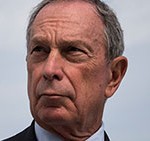Michael Bloomberg’s candidacy for president has an obvious appeal to the business community but not to the left-leaning voters expected to decide the Democratic primary for president. His record on real estate issues shows why.
As mayor from 2002 through 2013, Bloomberg’s pro-development policies were credited by business interests for powering New York City’s comeback and denounced by critics for increasing homelessness and inequality. Even decisions that seemed moderate or progressive at the time no longer do in the context of today’s politics.
Bloomberg presided over the construction of 40,000 buildings. His 120 rezonings set the stage for glassy towers in downtown Brooklyn, Williamsburg and Long Island City that are cheered by some for fostering the city’s rise and blamed by others for widening the chasm between the wealthy and everyone else. His administration encouraged but did not mandate affordability in new housing — a choice unlikely to impress Democratic voters next year.
Bloomberg was also known for putting city resources toward megaprojects, including the new Yankee Stadium, Citi Field, Atlantic Yards and Hudson Yards. The Yankees were allowed to use $866 million in tax-exempt financing, Citi Field got $100 million, Atlantic Yards — including Barclay’s Center — got $205 million for infrastructure and other elements and Hudson Yards got a $2.4 billion extension of the No. 7 subway line, among other benefits.
In 2004 the city made a $50 million commitment toward the creation of the High Line. Cornell Tech — among the few highlights of Bloomberg’s third term — grew on Roosevelt Island from his promise of free city land and up to $100 million in infrastructure work.
“He made it very clear that New York was open for business,” said developer MaryAnne Gilmartin, praising Bloomberg for encouraging “big, bold and audacious thinking.”
But one tenant leader saw the same record in the opposite light.
“No one has done more to accelerate the homelessness and displacement crisis in New York State than Michael Bloomberg,” said Cea Weaver, campaign coordinator for Housing Justice for All. “For 12 years he funneled public resources — land and money — to his corporate, billionaire friends.”
Read more



Some say Bloomberg was in bed with developers such as Related, whose Hudson Yards development was supported by $6 billion worth of city and state subsidies, tax breaks and infrastructure. Bonds for the subway project were funded by the property tax revenue it was predicted to generate. It was the first addition to the subway system since 1989 and unique in that the city paid for it, despite the Metropolitan Transportation Authority being a state entity.
Bloomberg was also seen as close to Tishman Speyer’s Jerry Speyer, who has a stake in the Yankees and sits on the board of the Federal Reserve Bank of New York. In 2006 the firm purchased Stuyvesant Town for $5.4 billion, a jaw-dropping price that meant Tishman Speyer would have had to push out many rent-stabilized tenants to generate a profit. That was the largest of many such acquisitions that private interests made without the mayor raising alarms, even as advocates for rent-regulated housing did.
Critics also tied Bloomberg’s policies to rising income inequality and a 69% increase in the city’s homeless-shelter population during his three terms, according to Coalition for the Homeless. The mayor attributed the jump to improved conditions in shelters making them more attractive, and in 2013 famously said, “Nobody’s sleeping on the streets.”
It was also under Bloomberg’s watch, in 2004, that the city ended regular funding for the New York City Housing Authority. A year later, Bloomberg also ended the policy of giving the homeless priority for NYCHA apartments — believing it encouraged people to enter the shelter system — and the authority stopped conducting lead inspections in 2012.
Weaver noted that tenants make up an “extremely important” bloc of the democratic base, and are not likely to vote for a “technocratic billionaire who spent 12 years allowing landlords to run New York.”
But Seth Pinsky, who served as president of the city’s Economic Development Corporation under Bloomberg, stressed that the administration’s policies were designed to have broad economic impact.
Bloomberg “recognized the city was growing and appropriately said, ‘If a city is going to grow and accommodate employment, we have to have development,’” Pinsky recalled. “The real estate industry happened to be the beneficiary.”
Bloomberg, in 2007, also became the first New York mayor to have a sustainability policy, the premise of which was to accommodate more people in the city because their carbon footprint would be smaller there than in the suburbs. At the same time, his 70 or so “contextual rezonings” locked in low-scale development in many communities, while allowing for bigger buildings on some commercial streets and near mass transit.
The mayor was appreciated by business interests for his approach to governing. That is, having funded his own campaigns and not seeking support from the county Democratic organizations, he didn’t have to repay political favors when staffing or running his administration.
“The most pro-development thing Mike Bloomberg ever did was do a good job being mayor,” said Jordan Barowitz, a former deputy press secretary for Bloomberg and now vice president of external affairs at the Durst Organization.
Pinsky and Barowitz both said Bloomberg made considerable demands of developers to ensure they built affordable housing and created public amenities as they benefited from favorable policies. Barowitz said the administration jump-started mixed-income development by becoming among the first to champion inclusionary housing in New York City.
However, Bloomberg rejected making inclusionary housing mandatory, preferring instead to allow developers to erect larger buildings if they included enough reduced-rent apartments. He even scuttled early efforts for voluntary inclusionary housing before implementing it in 2005 after pushback from affordable housing advocates upset by a Park Slope rezoning.
Ron Moelis, co-founder of L+M Development Partners, cautioned against thinking about inclusionary housing in 2019 terms. He noted that the mayor’s plan for inclusionary housing was “much more transparent and accretive” than the policies that preceded it.
“He put together an affordable housing policy that was probably the most robust in the country and put funding behind it that allowed New York City to take the lead in the building and preservation of affordable housing in a meaningful way,” Moelis added.
“It was also a time when development in the city wasn’t as robust, especially in the boroughs,” Moelis added. “The discussion wasn’t about gentrification, it was about incentivizing people to invest in neighborhoods. It was the forerunner of what Bill de Blasio did at the beginning of his administration, which was mandatory [inclusionary housing].”
Moelis said L+M undertook a number of residential developments that never would have happened prior to Bloomberg’s affordable housing policies. But a 2011 study found that of the 170,000 affordable units developed during Bloomberg’s administration, all but a third were too expensive for the majority of local residents. (That same criticism has been leveled at de Blasio’s housing policy.) Research also showed that many developers built purely market-rate housing rather than including affordable units in exchange for a density bonus.
Some say that under Bloomberg, New York increasingly became a city of “haves” and “have nots.”
“You have this tremendous wealth disparity where poverty is disproportionately placed on people of color and women,” said developer Don Peebles, who has publicly backed Joe Biden’s White House bid and donated to the campaigns of candidates Sen. Cory Booker and Deval Patrick.
Peebles gave Bloomberg credit for “saving” New York in the wake of 9/11 and for steering the city through the financial crisis, which came at the end of his second term. But he said during Bloomberg’s final four years, the administration did not do enough to promote inclusiveness. “It’s a heck of a challenge to change the seating at the table of wealth and power — it requires affirmative steps to do it,” he said.
“Anyone with $50 billion of personal wealth is not an underdog,” he added. “My question is whether the message is one that will resonate with the Democratic Party.”
